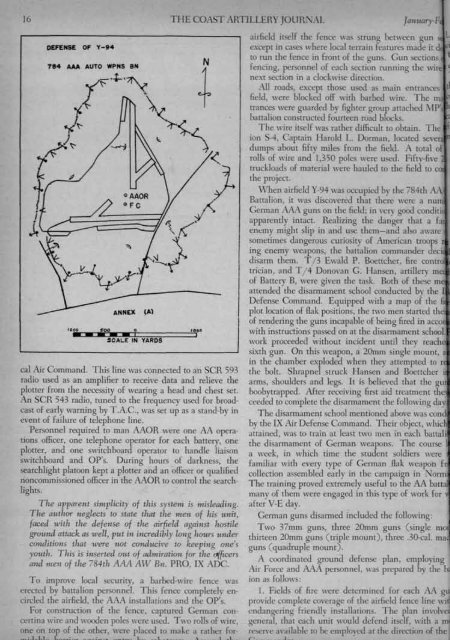January-February - Air Defense Artillery
January-February - Air Defense Artillery
January-February - Air Defense Artillery
You also want an ePaper? Increase the reach of your titles
YUMPU automatically turns print PDFs into web optimized ePapers that Google loves.
16<br />
DEFENSE OF Y-94<br />
184 AM AUTO WPHS 8N<br />
1000 _____ soo 01 1000 I<br />
!OALE IN YARDS<br />
cal <strong>Air</strong> Command. This line was connected to an SCB 593<br />
radio used as an amplifier to receive data and relieve the<br />
plotter from the necessity of wearing a head and chest set.<br />
An SCR 543 radio, tuned to the frequency used for broadcast<br />
of early warning by T.A.C., was set up as a stand-by in<br />
event of failure of telephone line.<br />
Personnel required to man AAOR were one AA operations<br />
officer, one telephone operator for each battery, one<br />
plotter, and one switchboard operator to handle liaison<br />
switchboard and OP's. During hours of darkness, the<br />
searchlight platoon kept a plotter and an officer or qualified<br />
noncommissioned officer in the AAOR to control the searchliohts.<br />
o<br />
The apparent simplicity of this s)'stem is misleading.<br />
The allthor neglects to state that the men of his unit,<br />
faced with the defense of the airfield against hostile<br />
ground attack as well, put in incredibly long hours under<br />
conditions that were not condudl'e to keeping one's<br />
)'olltl1. This is inserted out of admiration for the officers<br />
mId men of the 784th AAA A\V Bn. PRO, IX ADG<br />
To improve local security, a barbed-wire fence was<br />
erected by battalion personnel. This fence completely encircled<br />
the airfield, the AI\A installations and the OP's.<br />
For construction of the fence, captured German concertina<br />
wire and wooden poles were used. Two rolls of wire,<br />
one on top of the other, were placed to make a rather for-<br />
~:--l~l..1~ l..~_....:~_ ,,_ .:_ • __ • __ 1. ... 1. _ .. \ 1.1.<br />
THE COAST AHTILLEBY JOUR~AL<br />
airfield itself the fence was strung between gun<br />
except in cases where local terrain features made it d<br />
to run the fence in front of the ouns. Gun sections ~<br />
o<br />
fencing, personnel of each section running the wire l<br />
next section in a clockwise direction.<br />
All roads, except those used as main entrances<br />
field, were blocked off with barbed wire. The m<br />
trances were guarded by fighter group attached ~lP'<br />
battalion constructed fourteen road blocks.<br />
The wire itself was rather difficult to obtain. The<br />
ion S-4, Captain Harold L. Donnan, located sever<br />
dumps about fifty miles from the field. A total of<br />
rolls of wire and 1,350 poles were used. Fifty-five ~<br />
truckloads of material were hauled to the field to co<br />
the project.<br />
When airfield Y-94 was occupied by the 784th Al<br />
Battalion, it was discovered that there were anum<br />
German 1\AI\ guns on the field; in very good conditi<br />
apparently intact. Bealizing the danger that a fa<br />
enemy might slip in and use them-and also aware<br />
sometimes dangerous curiosity of American troops<br />
ing enemy weapons, the battalion commander deci<br />
disarm them. T /3 Ewald P. Boettcher, fire contro<br />
trician, and 1'/4' Donovan G. Hansen, artillery me<br />
of Battery B, were given the task. Both of these m<br />
attended the disarmament school conducted bv the I<br />
<strong>Defense</strong> Command. Equipped with a map of' the fi<br />
plot location of Aak positions, the two men started the'<br />
of rendering the guns incapable of being fired in accor<br />
with instructions passed on at the disarmament school.<br />
work proceeded without incident until they reach<br />
sixth gun. On this weapon, a 20mm single mount, a<br />
in the chamber exploded when they attempted to r<br />
the bolt. Shrapnel struck Hansen and Boettcher i<br />
arms, shoulders and legs. It is believed that the gu<br />
boobytrapped. After receiving first aid treatment the,<br />
ceeded to complete the disarmament the following day<br />
The disamlament school mentioned above was cond<br />
by the IX <strong>Air</strong> <strong>Defense</strong> Command. Their object, which<br />
attained, was to train at least two men in each barrali<br />
the disarmament of German weapons. The course<br />
a week, in which time the student soldiers were<br />
familiar with every type of German Aak weapon fr<br />
collection assembled early in the campaign in Norm<br />
The training proved extremely useful to the AA batta<br />
many of them were engaged in this type of work for<br />
after V-E day.<br />
German guns disarmed included the following:<br />
Two 37mm guns, three 20mm guns (single mo<br />
thirteen 20mm guns (triple mount), three .30-cal. ma<br />
guns (quadruple mount).<br />
A coordinated ground defense plan, employing<br />
<strong>Air</strong> Force and AAA personnel, was prepared by the bl<br />
ion as follows:<br />
I. Fields of fire were determined for each AA g~<br />
pro\'ide complete coverage of the airfield fence line w'id<br />
endangering friendly installations. The plan involved<br />
oeneral. that each unit would defend itself, with a m4<br />
"reserve available to be employed at the direction of the I<br />
r .1 _ t
















